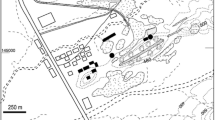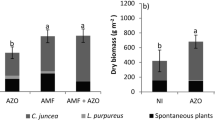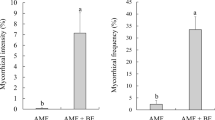Abstract
Development and heavy metal tolerance of two cultivation lineages of the indigenous isolate of arbuscular mycorrhizal fungus (AMF)Glomus intraradices PH5 were compared in a pot experiment in soil from lead (Pb) smelter waste deposits. One lineage was sub-cultured in original Pb-contaminated soil; the second one was maintained for 13 months in an inert substrate (river sand) without Pb stress. The contribution of these cultivation lineages to the Pb uptake and accumulation by the host plantAgrostis capillaris was investigated. The experiment was conducted in a compartmented system where the lateral compartments withAgrostis seedlings were separated from the central pot containing 4-week olderAgrostis plants by a nylon mesh for allowing out-growing of extraradical mycelium (ERM) from the pot.
No differences in mycorrhizal colonization, ERM length and viability were observed between the two lineages ofG. intraradices PH5 in the soil of the isolate origin. However, the ability to support plant growth and Pb uptake differed between the lineages and also between the plants in the central pots and the lateral compartments. The growth of the plants in the central pots was positively affected by AMF inoculation. The plants inoculated with the lineage maintained in original soil showed larger shoot biomass and higher shoot P content as compared to the other inoculation treatments. The shoot Pb concentration of these plants was lower when compared to the plants inoculated with the lineage sub-cultured in the inert substrate. However the concentration did not differ from non-mycorrhizal control or from the reference isolateG. intraradices BEG75 from non-contaminated soil. Also shoot Pb contents were similar for all inoculation treatments. The development ofG. intraradices BEG75 in the contaminated soil was very poor; this isolate was not able to initiate colonization of seedlings in lateral compartments. In lateral compartments, growth of seedlings in contaminated soil was inhibited by theG. intraradices PH5 lineage maintained in the inert substrate. Pb translocation from the seedling roots to shoots was increased for plants inoculated with either lineage as compared to the non-mycorrhizal control; however, the increase for the lineage cultivated in the inert substrate was significantly higher in comparison with that maintained in the original soil. After 13 months of cultivation in a metal free substrate, theG. intraradices isolate from Pb contaminated soil did not lose its tolerance to Pb as regards colonization of plant roots and growth of ERM in the soil of its origin. However, its ability to support plant growth and to prevent Pb translocation from the roots to the shoots was decreased.
Similar content being viewed by others
References
Brundrett M., Melville L. &Peterson R.L. (1994):Practical methods in mycorrhizal research. Mycologue Publications, Waterloo.
Dehn B. &Schüepp H. (1989): Influence of VA mycorrhizae on the uptake and distribution of heavy metals in plants.Agric. Ecosyst. Environm. 29: 79–83.
Del Val C., Barea J. M. &Azcón-Aguilar C. (1999): Assessing the tolerance to heavy metals of arbuscular mycorrhizal fungi isolated from sewage sludge-contaminated soils.Appl. Soil Ecol. 11: 261–269.
Díaz G., Azcón-Aguilar C. &Honrubia M. (1996): Influence of arbuscular mycorrhizae on the heavy metal (Zn and Pb) uptake and growth ofLygeum spartum andAnthyllis cytisoides.Pl. & Soil 180: 241–249.
El-Kherbawy M., Angle J.S., Heggo A. &Chaney R.L. (1989): Soil pH, rhizobia, and vesicular-arbuscular mycorrhizae inoculation effects on growth and heavy metal uptake of alfalfa (Medicago sativa L.).Biol. Fertil. Soils 8: 61–65.
Enkhtuya Batkhuugyin, Rydlová J. &Vosátka M. (2000): Effectiveness of indigenous and non-indigenous isolates of arbuscular mycorrhizal fungi in soils from degraded ecosystems and man-made habitats.Appl. Soil Ecol. 14: 201–211.
Gildon A. &Tinker P.B. (1981): A heavy metal tolerant strain of mycorrhizal fungus.Trans. Brit. Mycol. Soc. 77: 648–649.
Giovaetti M. &Mosse B. (1980): An evaluation of techniques for measuring vesicular-arbuscular mycorrhizal infection in roots.New Phytol. 84: 489–500.
Griffioen W.A.J. (1994): Characterization of a heavy metal-tolerant endomycorrhizal fungus from the surroundings of a zinc refinery.Mycorrhiza 4: 197–200.
Haselwandter K., Leyval C. &Sanders F.S. (1994): Impact of arbuscular mycorrhizal fungi on plant uptake of heavy metals and radionuclides from soil. In:Gianinazzi S. &Schüepp H. (eds.),Impact of arbuscular mycorrhizas on sustainable agriculture and natural ecosystems, Birkhäuser Verlag, Basel, pp. 179–189.
Heggo A., Angle J.S. &Chaney R.L. (1990): Effects of vesicular-arbuscular mycorrhizal fungi on heavy metal uptake by soybeans.Soil Biol. Biochem. 22: 865–869.
Hildebrandt U., Kaldorf M. &Bothe H. (1999): The zinc violet and its colonization by arbuscular mycorrhizal fungi.J. Pl. Physiol. 154: 709–717.
Joner E.J. &Leyval C. (2001): Time-course of heavy metal uptake in maize and clover as affected by root density and different mycorrhizal inoculation regimes.Biol. Fertil. Soils 33: 351–357.
Killham K. &Firestone M.K. (1983): Vesicular arbuscular mycorrhizal mediation of grass response to acidic and heavy metal deposition.Pl. & Soil 72: 39–48.
Kormanik P.P. &McGraw A.C. (1982): Quantification of vesicular-arbuscular mycorrhizae in plant roots. In:Schenck N.C. (ed.),Methods and principles of mycorrhizal research, American Phytopatological Society, St. Paul, pp. 37–45.
Kucey R.M.N. &Janzen H.H. (1987): Effects of VAM and reduced nutrient availability on growth and phosphorus and micronutrient uptake of wheat and field beans under greenhouse conditions.Pl. & Soil 104: 71–78.
Leyval C., Turnau K. &Haselwandter K. (1997) Effect of heavy metal pollution on mycorrhizal colonization and function: physiological, ecological and applied aspects.Mycorrhiza 7:139–153.
Loth F.G. &Höfner W. (1995): Einfluss der VA-Mykorrhiza auf die Schwermetallaufnahme von hafer (Avena sativa L.) in Abhängigheit vom Kontaminationsgrad der Boden.Z. Pflanzenernähr. Bodenk. 158: 339–345.
Malcová R., Albrechtová J. &Vosátka M. (2001) The role of extraradical mycelium network of arbuscular mycorrhizal fungi on establishment and growth ofCalamagrostis epigejos in industrial waste substrates.Appl. Soil Ecol. 18: 129–142.
Malcová R., Vosátka M. &Gryndler M. (2003a): Different effect ofGlomus intraradices inoculation on lead uptake byZea mays L. andAgrostis capillaris L.Appl. Soil Ecol. 646: 1–13.
Malcová R., Rydlová J. & Vosátka M. (2003b): Metal-free cultivation ofGlomus sp. BEG140 isolated from Mn-contaminated soil decreases its tolerance to higher Mn concentrations.Mycorrhiza (in press).
Meharg A.A. &Cairney J.W.G. (2000) Co-evolution of mycorrhizal symbionts and their hosts to metal-contaminated environments.Advances Ecol. Res. 30: 69–112.
Moore P.D. &Chapman S.B. (1986):Methods in plant ecology. Blackwell Scientific Publication, Oxford.
Olsen R.S. (1982): Phosphorus in: Methods in soil analysis.Agronomy 9: 403–430.
Shetty K.G., Hetrick B.A.D. &Schwab A.P. (1995): Effect of mycorrhizae and fertilizer amendment on zinc tolerance of plants.Environm. Pollut. 88: 307–314.
Schüepp H., Dehn B. &Sticher H. (1987): Interaktionen zwischen VA-Mykorrhizen und Schwermetallbelastungen.Angew. Bot. 61: 85–96.
Sylvia D.M. (1988): Activity of external hyphae of vesicular-arbuscular mycorrhizal fungi.Soil Biol. Biochem. 20: 39–43.
Tonin C., Vandenkoornhuyse P., Joner E.J., Straczek J. &Leyval C. (2001): Assessment of arbuscular mycorrhizal fungi diversity in the rhizosphere ofViola calaminaria and the effect of these fungi on heavy metal uptake by clover.Mycorrhiza 10: 161–168.
Walker C.M. &Trappe J.M. (1993): Names and epithets in theGlomales andEndogonales.Mycol. Res. 97: 339–344.
Weissenhorn I., Glashoff A., Leyval C. &Berthelin J. (1994): Differential tolerance to Cd and Zn of arbuscular mycorrhizal (AM) fungal spores isolated from heavy metal-polluted und unpolluted soils.Pl. & Soil 167: 189–196.
Weissenhorn I. &Leyval C. (1995): Root colonization of maize by a Cd-sensitive and a Cd-tolerantGlomus mosseae and cadmium uptake in sand culture.Pl. & Soil 175: 233–238.
Weissenhorn I., Leyval C., Belgy G. &Berthelin J. (1995): Arbuscular mycorrhizal contribution to heavy metal uptake by maize (Zea mays L.) in pot culture with contaminated soil.Mycorrhiza 5: 245–251.
Weissenhorn I., Leyval C. &Berthelin J. (1993): Cd-tolerant arbuscular-mycorrhizal (AM) fungi from heavy-metal polluted soil.Pl. & Soil 157: 247–256.
Author information
Authors and Affiliations
Corresponding author
Rights and permissions
About this article
Cite this article
Rydlová, J., Vosátka, M. Effect ofGlomus intraradices isolated from Pb-contaminated soil on Pb uptake byAgrostis capillaris is changed by its cultivation in a metal-free substrate. Folia Geobot 38, 155–165 (2003). https://doi.org/10.1007/BF02803148
Issue Date:
DOI: https://doi.org/10.1007/BF02803148




